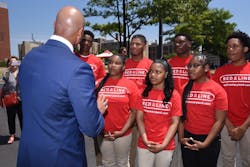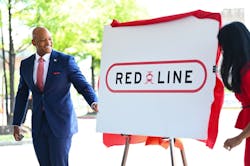Baltimore Red Line project to be light rail
The Baltimore Red Line project that was revived in 2023 by Maryland Gov. Wes Moore will be a light-rail line that will address a wide gap in east-west transit service between Bayview and Woodlawn, Md., through downtown Baltimore City. In addition, the Red Line will provide access to thousands of jobs in the Baltimore region, connecting communities to vital educational and employment centers.
“Transportation mobility and the access it affords is a foundation for economic vitality,” said Gov. Moore. “As the economic engine for our state, the greater Baltimore region deserves great transit—and together, we are investing in the infrastructure to make sure that everyone in the region can get from where they live to where opportunity lies. The Red Line will give Baltimoreans a convenient and sustainable way to travel and help unleash the full economic potential of this region.”
The selection of light-rail as the mode of transportation is based on technical analysis, including access, travel time, connections, reliability and ridership, in addition to consideration of the line’s cost effectiveness and significant and continuous input from the public.
"For far too many communities in Baltimore, pathways to go from where you live to where opportunities are simply do not exist," said Maryland Lt. Gov. Aruna Miller. "Today marks a monumental step in delivering on our promise to invest in Baltimore and its people and give them a long overdue transit system capable of moving them to and from work, to and from hospital care and school. This will be a system they deserve. In a city that has seen far too much of its history dictated by redlining, its future can be rewritten by a red line."
During the past ten months, the Maryland Department of Transportation Maryland Transit Administration (MDOT MTA) conducted the technical analysis and public outreach. Financial analysis also confirmed light-rail is more cost-effective over the long term compared to alternative transit modes such as bus rapid transit (BRT). While the initial capital cost of the light-rail line is higher than BRT, light- rail vehicles offer greater capacity, which will be an asset in the high-density corridor and lower the operational cost per rider and lead to increased ridership.
“Successful transit projects need to strike a balance that considers cost, long-term value and public support,” said MDOT Secretary Paul J. Wiedefeld. “Baltimore’s Red Line is one more example of our commitment to providing Marylanders with a transportation network that provides access to opportunities, services and resources that can support a better quality of life.”
“The Red Line is critical to the success of our region and will provide vital connections to educational and employment opportunities,” said MTA Administrator Holly Arnold. “The project team is continuing to advance this critical project as quickly as possible while ensuring the communities we serve are fully engaged.”
The MDOT MTA will continue its analysis and coordination with local partners to define the route alignment, including the extent to which the project includes tunneled segments. The preferred alignment is expected to be announced by the end of 2024 — which will reflect current conditions, growth patterns and project priorities.
The MTA has initiated the National Environmental Protection Agency review, which is required before final design can begin. As part of this process, a Supplemental Environmental Impact Statement also will be prepared and will build upon the extensive work completed a decade ago. The agency plans to enter the Federal Transit Administration’s Capital Investment Grants program in late 2024 – an initial step to receiving future federal funding for the construction of the Red Line.
“We have long talked and talked about the importance of the Red Line — and the crippling impact the original cancellation had on the city of Baltimore. Going from a former governor who took Baltimore off the map literally and figuratively to today’s announcement was a long road. It sends a message to residents that Baltimore is once again a priority,” said Baltimore Mayor Brandon M. Scott. “The time for talk is over and the time to actually move forward with a plan that works for all Baltimoreans is here. The choice to pursue a light-rail system, which is already a proven and beloved part of Baltimore’s public transportation network, is the right one. I am thrilled that we’re ready to take this step and look forward to finally seeing this project through to the end.”




